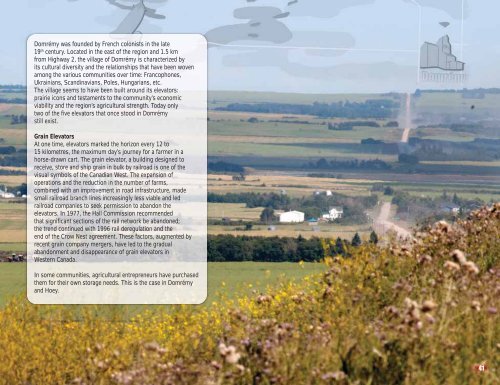Revue Saveurs et savoirs - Partie 2 (.pdf) - Assemblée ...
Revue Saveurs et savoirs - Partie 2 (.pdf) - Assemblée ...
Revue Saveurs et savoirs - Partie 2 (.pdf) - Assemblée ...
Create successful ePaper yourself
Turn your PDF publications into a flip-book with our unique Google optimized e-Paper software.
Domrémy was founded by French colonists in the late<br />
19 th century. Located in the east of the region and 1.5 km<br />
from Highway 2, the village of Domrémy is characterized by<br />
its cultural diversity and the relationships that have been woven<br />
among the various communities over time: Francophones,<br />
Ukrainians, Scandinavians, Poles, Hungarians, <strong>et</strong>c.<br />
The village seems to have been built around its elevators:<br />
prairie icons and testaments to the community’s economic<br />
viability and the region’s agricultural strength. Today only<br />
two of the five elevators that once stood in Domrémy<br />
still exist.<br />
Grain Elevators<br />
At one time, elevators marked the horizon every 12 to<br />
15 kilom<strong>et</strong>res, the maximum day’s journey for a farmer in a<br />
horse-drawn cart. The grain elevator, a building designed to<br />
receive, store and ship grain in bulk by railroad is one of the<br />
visual symbols of the Canadian West. The expansion of<br />
operations and the reduction in the number of farms,<br />
combined with an improvement in road infrastructure, made<br />
small railroad branch lines increasingly less viable and led<br />
railroad companies to seek permission to abandon the<br />
elevators. In 1977, the Hall Commission recommended<br />
that significant sections of the rail n<strong>et</strong>work be abandoned;<br />
the trend continued with 1996 rail deregulation and the<br />
end of the Crow Nest agreement. These factors, augmented by<br />
recent grain company mergers, have led to the gradual<br />
abandonment and disappearance of grain elevators in<br />
Western Canada.<br />
In some communities, agricultural entrepreneurs have purchased<br />
them for their own storage needs. This is the case in Domrémy<br />
and Hoey.<br />
41




